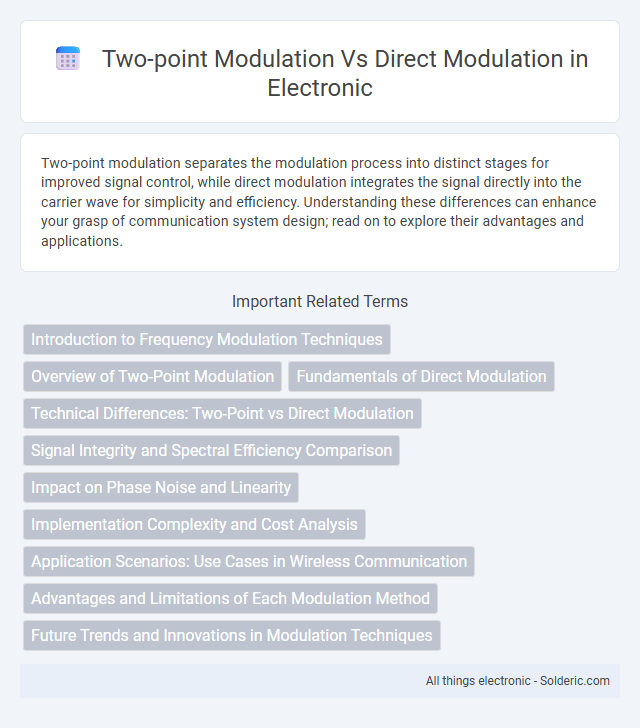Two-point modulation separates the modulation process into distinct stages for improved signal control, while direct modulation integrates the signal directly into the carrier wave for simplicity and efficiency. Understanding these differences can enhance your grasp of communication system design; read on to explore their advantages and applications.
Comparison Table
| Feature | Two-Point Modulation | Direct Modulation |
|---|---|---|
| Modulation Technique | Uses two distinct control points for signal modulation | Modulates laser current directly to vary output |
| Signal Quality | Higher signal fidelity, reduced distortion | Prone to chirp and higher noise |
| Complexity | More complex circuitry and control | Simpler design and implementation |
| Frequency Response | Improved frequency response with wider bandwidth | Limited bandwidth due to direct current modulation |
| Applications | Used in advanced optical communication systems | Common in low-cost, short-distance optical links |
| Cost | Higher due to complex components | Lower, cost-effective solution |
Introduction to Frequency Modulation Techniques
Frequency modulation techniques include two-point modulation and direct modulation, each offering unique advantages in signal transmission. Two-point modulation enhances signal stability by separately controlling frequency and amplitude components, while direct modulation directly varies the laser or oscillator frequency, leading to simpler system design but potential chirp effects. Your choice between these methods depends on the application's requirements for signal quality, complexity, and bandwidth efficiency.
Overview of Two-Point Modulation
Two-point modulation enhances signal clarity by adjusting both the amplitude and frequency of a carrier wave at distinct points, improving overall transmission efficiency compared to direct modulation. This technique reduces signal distortion and noise interference, making it ideal for complex communication systems requiring high fidelity. Understanding two-point modulation can help you optimize your system's performance by precisely controlling signal characteristics.
Fundamentals of Direct Modulation
Direct modulation involves varying the driving current of a laser diode to encode information onto the optical carrier, resulting in changes in frequency and intensity simultaneously. This method provides a simple and cost-effective approach for integrating modulation within the laser itself, but it can introduce chirp and limit signal quality over long distances. Understanding the fundamentals of direct modulation helps optimize Your optical communication system by balancing performance and complexity.
Technical Differences: Two-Point vs Direct Modulation
Two-point modulation separates the signal processing into two stages, allowing precise control over amplitude and phase by modulating distinct components independently, which enhances signal integrity and reduces distortion. Direct modulation applies the input signal straight to the laser or modulator, simplifying design but often introducing higher chirp and nonlinearities affecting overall performance. The technical distinction lies in two-point modulation's ability to optimize signal quality through dual control points, while direct modulation relies on a single modulation path with inherent limitations in linearity and bandwidth.
Signal Integrity and Spectral Efficiency Comparison
Two-point modulation offers superior signal integrity by reducing phase noise and distortion compared to direct modulation, which often suffers from chirp effects and broader linewidth. Spectral efficiency is enhanced in two-point modulation through precise control of the optical signal's phase and amplitude, leading to narrower spectral width and higher data transmission rates. Your communication system benefits from improved performance and lower error rates when adopting two-point modulation over direct modulation.
Impact on Phase Noise and Linearity
Two-point modulation significantly improves phase noise performance by separating the modulation and laser bias control, reducing intensity fluctuations that contribute to phase noise. In contrast, direct modulation directly alters the laser current, resulting in higher phase noise and degraded linearity due to nonlinear laser response. Your system benefits from two-point modulation's enhanced linearity, enabling more accurate and stable signal transmission in high-frequency applications.
Implementation Complexity and Cost Analysis
Two-point modulation systems generally involve higher implementation complexity due to the need for precise synchronization between two modulation points, increasing the design intricacies and calibration requirements. Direct modulation offers a simpler architecture by modulating the signal directly at the source, reducing hardware components and lowering overall system cost. Your choice may depend on balancing performance benefits with the budget and complexity constraints of your specific application.
Application Scenarios: Use Cases in Wireless Communication
Two-point modulation excels in applications requiring precise control of signal integrity, such as in advanced radar systems and high-speed wireless communication standards like 5G, where minimizing phase noise and non-linear distortions is critical. Direct modulation simplifies transmitter design and is favored in low-cost, short-range wireless devices like Wi-Fi and Bluetooth, where integration and power efficiency are prioritized. Your choice between these modulation techniques directly impacts system performance based on the specific demands of signal quality, range, and complexity in wireless communication scenarios.
Advantages and Limitations of Each Modulation Method
Two-point modulation offers precise control over signal phases, enhancing signal integrity and reducing distortion in complex communication systems. Direct modulation simplifies transmitter design by directly varying the laser's current, enabling cost-efficient and compact devices, but it often suffers from chirp and limited modulation bandwidth. Your choice depends on whether you prioritize performance and signal quality or cost and simplicity in your communication application.
Future Trends and Innovations in Modulation Techniques
Future trends in modulation techniques emphasize the integration of machine learning algorithms to enhance two-point modulation efficiency, enabling real-time adaptive control and error correction. Innovations in direct modulation focus on improving bandwidth utilization and reducing laser chirp through advanced materials and photonic integrated circuits. Both methods are converging towards hybrid modulation schemes that leverage the strengths of two-point and direct modulation for ultra-high-speed optical communication systems.
two-point modulation vs direct modulation Infographic

 solderic.com
solderic.com